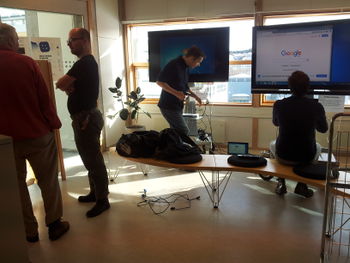Talk:Futurescapes
Getting everything ready for Futurescapes
Yesterday part of the Dragvoll library was closed in preparation of the Futurescapes event. Joost and Magnus were setting up the plenum, Christian, Tormod , Alex and Dorothee were busy with getting stands ready. Kari was already giving her first workshop on Designing with Girls for Girls: Games+Gender+Technology . Great to see so many things happening in the library!
--Typecraft (talk) 16:16, 12 March 2016 (CET)
Hi editors of the Futurescapes page
We are all very much looking forward to the Futurescapes Digital Humanities symposium coming up at NTNU in March 2016. The main organisers are Hanna Musiol and Dorothee Beermann, working together with other collaborators.
You will have noticed that the Futurescapes page is still changing a bit, and that we have been working also on the graphic representation. We are all very active and engaged and therefore a wiki tool like TypeCraft that allows collaborative editing is exactly the right place for us to prepare this event. Of course we adhere to the standard editing policy formulated for example in the Best Practice Guidelines for editing the Wikipedia.
The collaborative editing phrase will come to an end by next week, so that we can offer a stable site for announcing the conference, and a reference point for all of you who want to submit an abstract.
Until then: Here again some of the essential Best Practice Guidelines[1] as cited below:
Have fun editing!
--Typecraft (talk) 10:37, 25 September 2015 (CEST)
The normal editing process
In the normal case, editing is completely transparent. Editors interact with each other entirely within and through the article and edit summaries. This can be fostered by using the following editing practices:
- Make incremental changes
- Large changes in a single edit are difficult to read, and may be reverted by other editors on mere suspicion. Adding an entire section at once is usually acceptable, since it is self-contained. Making multiple changes in a single edit, particularly when edits stretch across different sections, should be avoided. Edits that might get reverted should be made as the last edit for the day. That way other editors have a chance to look it over, and can revert that single edit without undoing anything else.
- Use clear and informative edit summaries
- Edit summaries should briefly describe what was done, and suggest a justification if needed. This allows other editors to glance at the summary and skim the diffs to get a quick and accurate idea of what the change was.
- Have patience
- When other editor revise or revert edits, let some time pass before trying to address the issue. Hasty responses are usually ill-considered, and may appear to other editors to be pushy or tendentious.
- Keep and incorporate material
- It is generally better to revise rather than revert, to improve rather than exclude, and to expand rather than reduce. Only remove material where it is clearly incorrect, out of context, over-represented, or in other ways detracts more than it adds to the encyclopedia.
- ↑ https://en.wikipedia.org/wiki/Wikipedia:Good_editing_practices Wikipedia's Best Practice Guidelines.]
